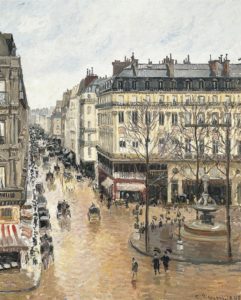While there has been significant progress made in the effort to return art stolen by the Nazis either to their countries of origin or the descendants of their former owners, sometimes not everything can go exactly the way you want. The heirs of Lilly Neubauer found this out recently when a California court decided that one of Spain’s major museums can keep a Pissarro painting which some argue should be returned to the family. Neubauer owned Pissarro’s 1897 painting Rue Saint Honoré, apres midi, effet de pluie until the Nazi government forced her to sell it in exchange for visas for her family. She eventually relented and sold the painting for 900 Reichsmarks, or about $360 at the time (slightly under $7,900 today). In 1958, the West German government declared Neubauer was the painting’s rightful owner and granted her a large sum equivalent to about $250,000 today.
Unknown to the family, Rue Saint Honoré was in a private collection in St. Louis between 1952 and 1976. It was then sold to Baron Hans Heinrich Thyssen-Bornemisza, a Swiss art collector with a title from Hungarian nobility whose family had earned a fortune in steel production in Germany. Today, the baron’s collection forms the core of the Thyssen-Bornemisza Museum, one of the three main museums in Madrid alongside the Prado and the Reina Sofía. In 1999, Neubauer’s grandson Claude Cassirer learned that the museum had his family’s painting and in 2001 began petitioning for its return. In 2005, he filed a lawsuit in the district court for the Central District of California under the Foreign Sovereign Immunities Act, given that the Spanish government owns the museum and its contents. That law provides immunity to foreign governments in suits brought in American courts but with several exceptions. One of those exceptions is if the suit involves “property taken in violation of international law.” By 2022, the case went to the United States Supreme Court. The lower courts had decided that the Cassirer family’s lawsuit qualified for this particular exception, and therefore, they could sue the Thyssen-Bornemisza Museum in American courts. However, there was also the problem of what law to use in this dispute. The laws of Spain, where the painting is located? Or the laws of California, where the lawsuit was filed? The Supreme Court dismissed the lower courts’ findings and returned the case to them for further review.
In a unanimous decision, the judges of the 9th Circuit Court of Appeals in Pasadena decided that Spanish law should apply in this case rather than California law. In his opinion, Judge Carlos Bea wrote, “We conclude that, under the facts of this case, Spain’s governmental interests would be more impaired by the application of California law than would California’s governmental interests be impaired by the application of Spanish law.” Under California law, stolen property had to be returned to its rightful owner regardless of whether or not the current owner knew it was stolen. Under Spanish law, however, an individual or entity may keep a previously stolen work if it was displayed in good faith for at least three years, the requirements for a proper transfer of title. The Thyssen-Bornemisza Museum insists that they did their due diligence and had no knowledge that the painting was sold under duress, meaning they had displayed it in good faith. But even though the appellate court agreed that, legally speaking, the museum is allowed to keep the Pissarro painting, in a concurrence, Judge Consuelo Callahan reminded that Spain is a party to the Terezin Declaration on Holocaust Era Assets and Related Issues. Therefore, she urged the museum to hand over the painting voluntarily since they cannot order their compliance.

